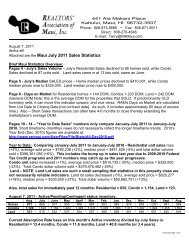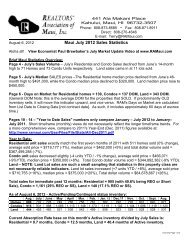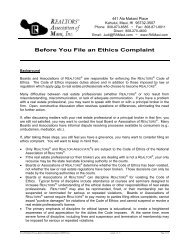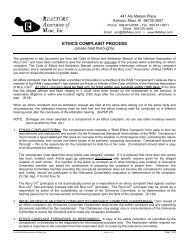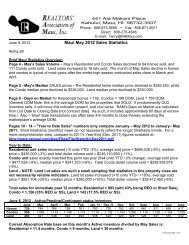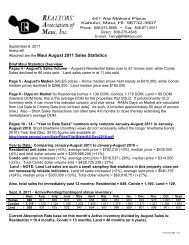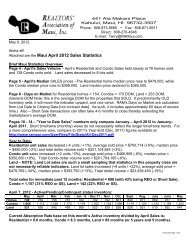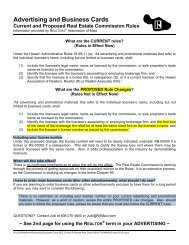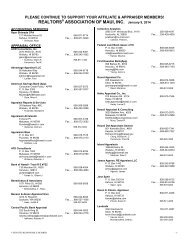Housing after the recovery - REALTORS® Association of Maui, Inc.
Housing after the recovery - REALTORS® Association of Maui, Inc.
Housing after the recovery - REALTORS® Association of Maui, Inc.
Create successful ePaper yourself
Turn your PDF publications into a flip-book with our unique Google optimized e-Paper software.
<strong>Housing</strong> <strong>after</strong> <strong>the</strong> <strong>recovery</strong><br />
Prepared for <strong>the</strong><br />
Realtors <strong>Association</strong> <strong>of</strong> <strong>Maui</strong><br />
July 16, 2010<br />
by Paul H. Brewbaker, Ph.D.<br />
Principal, TZ Economics<br />
Special mahalo to<br />
Terry Tolman!
The business cycle<br />
Slide copyright TZ Economics<br />
1
Real activity (U.S. GDP) in levels<br />
“Average” recession<br />
Previous 7 U.S. recessions<br />
Index <strong>of</strong> real GDP: peak quarter = 1.0<br />
1.050<br />
1.025<br />
1.000<br />
0.975<br />
2007Q4<br />
(December)—<br />
<strong>of</strong>ficial NBER<br />
“peak”<br />
2001 dot.com recession<br />
Real GDP and FRB forecasts<br />
Peak quarter<br />
2008<br />
Q2<br />
2009<br />
Q2<br />
The Great Recession<br />
F (2010q3)<br />
F (2010q2)<br />
2010q1 released 6/25<br />
Recession<br />
Recovery<br />
Expansion<br />
0.950<br />
-6 -3 0 3 6 9<br />
Slide copyright TZ Economics<br />
Source: Pr<strong>of</strong>essor Robert Hall, Stanford University and Chair, NBER Dating Committee; Bureau <strong>of</strong> Economic<br />
Analysis, U.S. Department <strong>of</strong> Commerce; chart by TZE includes June 25, 2010 release for 2010q1 (revised)<br />
2
Real GDP growth rate (U.S., decomposed)<br />
6<br />
P<br />
T<br />
Quarterly percent changes at annual rates<br />
3<br />
0<br />
-3<br />
-6<br />
-9<br />
-12<br />
Real GDP growth rate<br />
Inventory change<br />
Consumption<br />
Capital formation<br />
Government<br />
Net exports<br />
NBER recession<br />
dates shaded<br />
(presumed)<br />
Brewbaker<br />
recession<br />
call (box)<br />
2005 2006 2007 2008 2009 2010<br />
A consumption<br />
break “activated”<br />
<strong>the</strong> recession, and<br />
consumption has<br />
led <strong>the</strong> <strong>recovery</strong><br />
Slide copyright TZ Economics<br />
Source: BEA, U.S. Department <strong>of</strong> Commerce (June 25, 2010); graphic and calculations by TZE<br />
3
Recent U.S. real GDP forecasts<br />
8<br />
P<br />
T<br />
Quarterly annualized growth in percent<br />
4<br />
0<br />
-4<br />
-8<br />
Crisis<br />
Lehman<br />
Top 5<br />
Bottom 5<br />
NABE forcast May 24<br />
Actual posted Jun 25<br />
U.S. real economic<br />
growth forecasts<br />
are around <strong>the</strong><br />
long-term potential<br />
trend growth rate,<br />
following <strong>the</strong> deep<br />
2008-09 recession<br />
NBER recession shaded<br />
06 07 08 09 10 11<br />
Slide copyright TZ Economics<br />
Source:<br />
Bureau <strong>of</strong> Economic Analysis, National <strong>Association</strong> for Business Economics; revised 2010Q1 data released<br />
June 25, 2010<br />
4
Federal Reserve real GDP growth forecasts<br />
Slide copyright TZ Economics<br />
Source:<br />
Minutes <strong>of</strong> <strong>the</strong> June 22-23, 2010 meeting <strong>of</strong> <strong>the</strong> Federal Open Market Committee<br />
(http://www.federalreserve.gov/newsevents/press/monetary/fomcminutes20100623.pdf)<br />
5
Federal Reserve economic forecasts<br />
As close to longrun<br />
policy targets<br />
as you will get<br />
Slide copyright TZ Economics<br />
Source:<br />
Minutes <strong>of</strong> <strong>the</strong> June 22-23, 2010 meeting <strong>of</strong> <strong>the</strong> Federal Open Market Committee<br />
(http://www.federalreserve.gov/newsevents/press/monetary/fomcminutes20100623.pdf)<br />
6
Obama Administration end-2009 economic forecast<br />
Note: based on data<br />
avilable as <strong>of</strong> November<br />
18, 2009. Interest rate on<br />
91-day Treasury bills is<br />
measured on a secondary<br />
market discount basis.<br />
The figures do not reflect<br />
<strong>the</strong> upcoming BLS<br />
benchmark revision,<br />
which was expected to<br />
reduce 2008 and 2009 job<br />
growth by a cumulative<br />
824,000 jobs.<br />
Slide copyright TZ Economics<br />
Source: Council <strong>of</strong> Economic Advisers, Economic Report <strong>of</strong> <strong>the</strong> President (February 2010), Table 2-3<br />
(http://www.gpoaccess.gov/eop/2010/2010_erp.pdf)<br />
7
“…at <strong>the</strong> current pace <strong>the</strong> economy will have recovered<br />
by <strong>the</strong> third quarter <strong>of</strong> 2010, next quarter!”<br />
Advertiser, , who wrote <strong>the</strong> headline?<br />
Slide copyright TZ Economics<br />
Source: Honolulu Advertiser archives,<br />
http://<strong>the</strong>.honoluluadvertiser.com/article/2010/May/02/op/hawaii5020305.html<br />
8
The <strong>recovery</strong><br />
is almost over!<br />
Slide copyright TZ Economics<br />
Source: National <strong>Association</strong> for Business Economics<br />
Public version available at http://nabe.com/publib/macsum.html<br />
9
“…<strong>the</strong> economic <strong>recovery</strong> is proceeding…”<br />
FOMC 6/23/10<br />
Slide copyright TZ Economics<br />
Source: Federal Reserve Board,<br />
http://www.federalreserve.gov/newsevents/press/monetary/20100623a.htm<br />
10
U.S. potential real GDP growth rate calculation<br />
Slide copyright TZ Economics<br />
Source: Council <strong>of</strong> Economic Advisers, Economic Report <strong>of</strong> <strong>the</strong> President (February 2010), Box 2-1<br />
(http://www.gpoaccess.gov/eop/2010/2010_erp.pdf)<br />
11
Double dip is an ice cream serving<br />
Short-term performance:<br />
• Oahu > Hawaii (state) > U.S. <strong>recovery</strong> > Neighbor Islands<br />
• “National average” <strong>recovery</strong> is almost over: real GDP expansion<br />
• Oahu’s unemployment rate (5.5%) almost “full employment” in <strong>the</strong> U.S.*<br />
Long-term performance:<br />
• State projects 1.6 percent real Hawaii personal income growth 2010-35<br />
• U.S. productivity growth is ≥ 2 percent annually<br />
• Labor force growth is ≈ 1 percent annually<br />
• Potential annual real GDP growth should be ≤ 3 percent (less ≈ 0.5%)<br />
Expectations and policy may be shooting too low<br />
*Google “NAIRU” (non-accelerating inflation rate <strong>of</strong> unemployment) which many conjecture is in <strong>the</strong> neighborhood <strong>of</strong> 5.5 percent. The<br />
Federal Reserve publishes “Longer run” estimates interpreted by many as guiding monetary policy ranging from about 5 to 6 percent.<br />
Oahu’s May 2010 unemployment rate was, by TZE calculation, a seasonally-adjusted 5.4 percent.<br />
Source: Hawaii DBEDT, series “are nei<strong>the</strong>r targets nor goals”;<br />
http://hawaii.gov/dbedt/info/economic/data_reports/2035LongRangeSeries/LRFreport_2035series_revised_Aug09.pdf<br />
Slide copyright TZ Economics<br />
12
Some Hawaii macroeconomic metrics<br />
Slide copyright TZ Economics<br />
13
Hawaii payroll employment and change<br />
640<br />
620<br />
Thousands, s.a. (log scale)<br />
4<br />
Thousands, s.a.<br />
600<br />
580<br />
0<br />
560<br />
-4<br />
540<br />
NBER recessions shaded<br />
-8<br />
520<br />
1990 1995 2000 2005 2010 90 95 00 05 10<br />
Total payroll employment, s.a. . (jobs) Monthly employment change (jobs)<br />
Slide copyright TZ Economics<br />
Source: Hawaii DLIR, DBEDT; seasonal adjustment by TZE<br />
14
Hawaii payroll employment change<br />
NBER recessions shaded<br />
4<br />
.4<br />
Thousands, s.a.<br />
0<br />
-4<br />
.0<br />
-.4<br />
Millions, s.a.<br />
-8<br />
US (right scale)<br />
Hawaii (left)<br />
-.8<br />
00 02 04 06 08 10<br />
Slide copyright TZ Economics<br />
Source: U.S. BLS (via FRB St. Louis), Hawaii DLIR, DBEDT; seasonal adjustment <strong>of</strong> Hawaii data by TZE<br />
15
Unemployment rates show relative performance<br />
10<br />
8<br />
Neighbor Islands<br />
Statewide<br />
Oahu<br />
1. Three recessions, 90’s<br />
Japan Bubble long, 2001<br />
dot.com bubble mild,<br />
2008-09 Great<br />
Recession severe<br />
Percent, s.a.<br />
6<br />
4<br />
9/11<br />
SARS<br />
2. Neighbor islands led<br />
<strong>recovery</strong> in late-1990s,<br />
lag <strong>recovery</strong> in 2010<br />
3. Oahu low structural<br />
unemployment rate over<br />
<strong>the</strong> business cycle<br />
2<br />
4. Also notable: Neighbor<br />
Island match with Oahu<br />
unemployment rate,<br />
1999-2006 (a first!)<br />
Gulf<br />
0<br />
90 95 00 05 10<br />
Slide copyright TZ Economics<br />
Source: Hawaii DLIR, DBEDT; seasonal adjustment by TZE<br />
16
Honolulu inflation vs. unemployment trade-<strong>of</strong>f<br />
Inflation rate (%)<br />
8<br />
6<br />
4<br />
2<br />
1991(H1)<br />
2006(H2)<br />
Semiannual<br />
Honolulu data<br />
1984-2009<br />
2009(H2)<br />
Intensity <strong>of</strong> <strong>the</strong> Great Recession is<br />
reflected in <strong>the</strong> rapid transition from<br />
“boom” to “bust”—three years in <strong>the</strong><br />
recent cycle to cover <strong>the</strong> ground that<br />
took seven years to traverse during<br />
<strong>the</strong> 1990s. Honolulu inflation should<br />
converge to just above <strong>the</strong> U.S. core<br />
inflation expectation <strong>of</strong> 2 percent,<br />
0<br />
-2<br />
1998(H2)<br />
1 2 3 4 5 6 7<br />
Unemployment rate (%)<br />
Source: Bureau <strong>of</strong> Labor Statistics, U.S. Department <strong>of</strong> Labor; seasonal adjustment, regression by TZE<br />
Slide copyright TZ Economics<br />
17
Hawaii forecasts: real personal income growth<br />
6<br />
Quarterly percent change, y-o-y<br />
4<br />
2<br />
0<br />
-2<br />
NBER recession shaded<br />
Forecast<br />
02 04 06 08 10 12<br />
Source:<br />
Bureau <strong>of</strong> Economic Analysis; TZ Economics (forecast)<br />
Slide copyright TZ Economics<br />
18
<strong>Maui</strong> jobs data<br />
Slide copyright TZ Economics<br />
19
<strong>Maui</strong> payroll employment<br />
Thousands, s.a. (log scale)<br />
10.5<br />
10.0<br />
9.5<br />
9.0<br />
8.5<br />
8.0<br />
7.5<br />
Private (right scale)<br />
Public (left scale)<br />
NBER recessions shaded<br />
9/11<br />
Aloha/ATA<br />
shutdown<br />
68<br />
64<br />
60<br />
56<br />
52<br />
48<br />
Thousands, s.a. (log scale)<br />
7.0<br />
98 00 02 04 06 08 10<br />
Slide copyright TZ Economics<br />
Source: Hawaii DLIR, DBEDT; seasonal adjustment by TZE<br />
20
<strong>Maui</strong> employment: cycles and shocks<br />
Percent, s.a. (level scale)<br />
10<br />
8<br />
6<br />
4<br />
2<br />
Payroll employment (right)<br />
Unemployment rate (left)<br />
NBER recessions shaded<br />
Iniki<br />
9/11<br />
Aloha/ATA<br />
shutdown<br />
76<br />
72<br />
68<br />
64<br />
60<br />
56<br />
52<br />
48<br />
Thousands, s.a. (log scale)<br />
0<br />
90 95 00 05 10<br />
Slide copyright TZ Economics<br />
Source: Hawaii DLIR, DBEDT; seasonal adjustment by TZE<br />
21
<strong>Housing</strong> markets<br />
Slide copyright TZ Economics<br />
22
Case-Shiller<br />
SF same home price indexes:<br />
<strong>the</strong> 2000s house price bubble<br />
NBER recessions shaded<br />
Index, January 2000 = 100, s.a. (log scale)<br />
200<br />
100<br />
Denver<br />
Phoenix<br />
Las Vegas<br />
Los Angeles<br />
San Diego<br />
San Francisco<br />
50<br />
00 02 04 06 08 10<br />
Slide copyright TZ Economics<br />
Source: Standard & Poor’s (http://www.standardandpoors.com/indices/sp-case-shiller-home-priceindices/en/us/?indexId=spusa-cashpidff--p-us----)<br />
23
Case-Shiller<br />
SF same home price indexes:<br />
extreme bubbliciousness<br />
Index, January 2000 = 100, s.a. (log scale)<br />
200<br />
100<br />
50<br />
Las Vegas<br />
Phoenix<br />
NBER recessions shaded<br />
1990 1995 2000 2005 2010<br />
Slide copyright TZ Economics<br />
Source: Standard & Poor’s (http://www.standardandpoors.com/indices/sp-case-shiller-home-priceindices/en/us/?indexId=spusa-cashpidff--p-us----)<br />
24
Long-run median SF pricing trends look log-linear<br />
linear<br />
Thousand dollars, s.a. (log scale)<br />
800<br />
400<br />
200<br />
ln (P Oahu<br />
) =4.7456 + 0.0120(T)<br />
(0.0558) (0.0006)<br />
(where T = quarters, 1983.1-2010.1)<br />
<strong>Maui</strong><br />
100<br />
Kauai<br />
Orange Co., CA<br />
Oahu<br />
50<br />
75 80 85 90 95 00 05 10<br />
4.9% (Oahu)<br />
Slide copyright TZ Economics<br />
Source: National <strong>Association</strong> <strong>of</strong> Realtors, Honolulu Board <strong>of</strong> Realtors, Realtors <strong>Association</strong> <strong>of</strong> <strong>Maui</strong>, Hawaii Information<br />
Service (Kauai); all calculations and seasonal adjustment by TZE<br />
25
Median single-family home prices:<br />
bottomed out, except on <strong>Maui</strong><br />
800<br />
NBER recessions shaded<br />
Quarterly, thousand $, s.a.<br />
400<br />
Oahu<br />
<strong>Maui</strong><br />
Orange Co., CA<br />
San Diego, CA<br />
Overshoot?<br />
200<br />
98 00 02 04 06 08 10<br />
Slide copyright TZ Economics<br />
Sources: Honolulu Board <strong>of</strong> Realtors; Realtors <strong>Association</strong> <strong>of</strong> <strong>Maui</strong>, Hawaii Information Service, UHERO, National<br />
<strong>Association</strong> <strong>of</strong> Realtors; seasonal adjustment calculations by TZE<br />
26
<strong>Maui</strong> quarterly existing home sales<br />
1000<br />
NBER recessions shaded<br />
Units, s.a. (log scale)<br />
100<br />
Single-family<br />
Condominium<br />
10<br />
80 85 90 95 00 05 10<br />
Slide copyright TZ Economics<br />
Source: Realtors <strong>Association</strong> <strong>of</strong> <strong>Maui</strong>; seasonal adjustment by TZE<br />
27
<strong>Maui</strong> quarterly existing home sales<br />
800<br />
Units, s.a. (log scale)<br />
400<br />
200<br />
Single-family<br />
Condominium<br />
Lehman<br />
100<br />
NBER recession shaded<br />
05 06 07 08 09 10 11<br />
Slide copyright TZ Economics<br />
Source: Realtors <strong>Association</strong> <strong>of</strong> <strong>Maui</strong>; seasonal adjustment by TZE<br />
28
<strong>Maui</strong> existing home sale mean prices<br />
Thousand dollars, s.a. (log scale)<br />
800<br />
400<br />
200<br />
Single-family<br />
Condominium<br />
NBER recessions shaded<br />
100<br />
80 85 90 95 00 05 10<br />
Slide copyright TZ Economics<br />
Source: Realtors <strong>Association</strong> <strong>of</strong> <strong>Maui</strong>; seasonal adjustment, HP filter trend calculation by TZE<br />
29
<strong>Maui</strong> existing home sale mean prices<br />
Thousand dollars, s.a. (log scale)<br />
1200<br />
1000<br />
800<br />
600<br />
400<br />
NBER recession shaded<br />
Lehman<br />
Single-family<br />
Condominium<br />
05 06 07 08 09 10 11<br />
Slide copyright TZ Economics<br />
Source: Realtors <strong>Association</strong> <strong>of</strong> <strong>Maui</strong>; seasonal adjustment by TZE<br />
30
<strong>Maui</strong> existing home sale median prices<br />
800<br />
Single-family<br />
Condominium<br />
Thousand dollars, s.a. (log scale)<br />
400<br />
200<br />
NBER recessions shaded<br />
Lehman<br />
465k<br />
430k<br />
98 00 02 04 06 08 10<br />
Slide copyright TZ Economics<br />
Source: Realtors <strong>Association</strong> <strong>of</strong> <strong>Maui</strong>; seasonal adjustment by TZE<br />
31
<strong>Maui</strong> SF median home price higher-order moments<br />
Kurtosis (right scale)<br />
Standard dev./mean (x100)<br />
Skewness (left scale)<br />
250<br />
200<br />
150<br />
100<br />
14<br />
12<br />
10<br />
8<br />
6<br />
4<br />
2<br />
90 95 00 05 10<br />
50<br />
0<br />
Slide copyright TZ Economics<br />
Source: Realtors <strong>Association</strong> <strong>of</strong> <strong>Maui</strong>; moment calculations by TZE<br />
32
Summarizing housing market outcomes<br />
• Hawaii proved to be less <strong>of</strong> “bubblicious” housing markets, although<br />
<strong>Maui</strong> experience is more similar to California than Oahu<br />
• “Overshoot” <strong>of</strong> house price declines <strong>after</strong> Lehman resulted in modest<br />
bounce in winter/spring 2009—stabilization anticipated for some time<br />
• Sales volumes, on <strong>the</strong> o<strong>the</strong>r hand, have clearly rebounded and probably<br />
have begun a long period <strong>of</strong> growth through <strong>the</strong> mid-teens (2008-<br />
20teens) similar to to 1998-2005 experience<br />
• Notable anomaly, near equivalence <strong>of</strong> single-family and condominium<br />
prices towards end <strong>of</strong> 2007, appears to have partly unwound<br />
• Higher-order moments <strong>of</strong> underlying home price distribution are not<br />
definitive, but suggestive regarding whe<strong>the</strong>r valuation turning point has<br />
commenced—best guess is fairly stable valuations through 2012 as<br />
bottom-fishing absorbs distressed properties<br />
• <strong>Maui</strong> does not seem to have an inventory overhang like most distressed<br />
mainland markets, and home production is way too low for glut<br />
Slide copyright TZ Economics<br />
33
<strong>Housing</strong> construction<br />
Slide copyright TZ Economics<br />
34
Hawaii new housing units / existing inventory: (∆K(<br />
t / K t )<br />
Percent <strong>of</strong> existing housing stock<br />
.08<br />
.07<br />
.06<br />
.05<br />
.04<br />
.03<br />
.02<br />
.01<br />
2.5% pop. gr.<br />
Production has fallen because <strong>of</strong> regulatory<br />
restriction from two to three times <strong>the</strong> population<br />
growth rate to a pace that doesn’t t even endow <strong>the</strong><br />
newborn with <strong>the</strong> existing per capita housing stock<br />
1.5% pop. gr.<br />
1.0% pop. gr.<br />
.00<br />
60 65 70 75 80 85 90 95 00 05 10<br />
Slide copyright TZ Economics<br />
Sources: County Building Departments; Bank <strong>of</strong> Hawaii; U.S. Bureau <strong>of</strong> <strong>the</strong> Census; Hawaii DBEDT; TZE<br />
35
Oahu and Neighbor Island private building permits<br />
320<br />
Monthly, million 2009$, s.a., log scale<br />
160<br />
80<br />
40<br />
NBER recessions shaded<br />
20<br />
90 95 00 05 10<br />
Oahu<br />
Neighbor Isle<br />
Slide copyright TZ Economics<br />
Source: Hawaii DBEDT, County Building Departments, Bureau <strong>of</strong> <strong>the</strong> Census; seasonal adjustment, deflation, and<br />
Hodrick-Prescott filter trend-fitting by TZE<br />
36
Oahu and Neighbor Island new housing units authorized<br />
Oahu ( >1980)<br />
Neighbor Isle<br />
Quarterly, units, s.a., log scale<br />
1000<br />
NBER recessions shaded<br />
100<br />
75 80 85 90 95 00 05 10<br />
Slide copyright TZ Economics<br />
Source: Hawaii DBEDT, County Building Departments; seasonal adjustment and H-P filter trend-fitting by TZE<br />
37
<strong>Maui</strong> new housing units authorized<br />
Quarterly, units, s.a., log scale<br />
1000<br />
100<br />
NBER recessions shaded<br />
75 80 85 90 95 00 05 10 15<br />
Slide copyright TZ Economics<br />
Source: Hawaii DBEDT, County Building Departments; seasonal adjustment and H-P filter trend-fitting by TZE<br />
38
Total Hawaii real contracting (through 2009)<br />
8<br />
Monthly, billion 2009$, s.a., (log scale)<br />
4<br />
2<br />
NBER recessions shaded<br />
80 85 90 95 00 05 10<br />
Slide copyright TZ Economics<br />
Source: Hawaii DoTax, U.S. Bureau <strong>of</strong> <strong>the</strong> Census; deflation using Census cost index, seasonal adjustment by TZE<br />
39
Tourist arrivals<br />
• Supply reduction from airline shutdowns (Aloha, ATA; March/April 2008)<br />
preceded consumption and investor pullback before and <strong>after</strong> <strong>the</strong><br />
collapse <strong>of</strong> Lehman Bro<strong>the</strong>rs (September 2008)<br />
• Domestic arrivals stayed at bottom <strong>of</strong> March-September 2008 drop<br />
through spring 2008; international arrivals bounced back from <strong>the</strong> H2N1-<br />
A shock (spring 2009)<br />
• <strong>Maui</strong> and <strong>the</strong> Neighbor islands were exposed to greater losses from <strong>the</strong><br />
airline shutdowns than Oahu<br />
• <strong>Maui</strong> less dependent on international arrivals than Oahu, so its exposure<br />
to domestic arrivals declines cannot be “diversified away”<br />
• Hotels now starting to stabilize as room rates have dropped enough to<br />
start rebuilding occupancy, especially on <strong>Maui</strong><br />
• Lift commitments for summer 2010—<strong>after</strong> seasonal adjustment—point to<br />
incipient <strong>recovery</strong> in seasonally-adjusted volumes in second half 2010<br />
Slide copyright TZ Economics<br />
40
Hawaii total visitor arrivals<br />
650<br />
NBER recessions shaded<br />
Monthly in thousands, s.a., log scale<br />
600<br />
550<br />
500<br />
450<br />
400<br />
Aloha/ATA<br />
shutdowns<br />
90 95 00 05 10<br />
Slide copyright TZ Economics<br />
Source: Hawaii DBEDT, Hawaii Tourism Authority; seasonal adjustment by TZE<br />
41
Hawaii visitor arrivals by origin<br />
Thousands, s.a., (log scale)<br />
Thousands, s.a., (log scale)<br />
480<br />
220<br />
200<br />
440<br />
Lehman<br />
180<br />
160<br />
400<br />
140<br />
Aloha/ATA<br />
shutdowns<br />
120<br />
SARS<br />
360<br />
NBER recession shaded<br />
04 05 06 07 08 09 10<br />
100<br />
9/11<br />
H1N1<br />
02 04 06 08 10<br />
Domestic<br />
International<br />
Slide copyright TZ Economics<br />
Source: Hawaii DBEDT, Hawaii Tourism Authority; seasonal adjustment by TZE<br />
42
Total arrivals on <strong>Maui</strong>, Kauai: bigger hits than 9/11<br />
<strong>Maui</strong> (right scale)<br />
Kauai (left)<br />
240<br />
220<br />
Monthly in thousands,<br />
s.a., log scale<br />
120<br />
110<br />
100<br />
90<br />
80<br />
70<br />
Aloha/ATA<br />
shutdown<br />
200<br />
180<br />
160<br />
140<br />
120<br />
Monthly in thousands,<br />
s.a., log scale<br />
60<br />
NBER recessions shaded<br />
00 01 02 03 04 05 06 07 08 09 10<br />
Slide copyright TZ Economics<br />
Source: Hawaii DBEDT, Hawaii Tourism Authority; seasonal adjustment by TZE<br />
43
<strong>Maui</strong> monthly visitor arrivals through May 2010<br />
Domestic (right scale)<br />
International (left)<br />
200<br />
180<br />
Monthly in thousands, s.a., log scale<br />
80<br />
40<br />
20<br />
Y2K<br />
NBER recessions shaded<br />
Aloha/ATA<br />
shutdowns<br />
160<br />
140<br />
120<br />
100<br />
9/11<br />
SARS<br />
H1N1-A<br />
00 05 10<br />
Slide copyright TZ Economics<br />
Source: Hawaii DBEDT, Hawaii Tourism Authority; seasonal adjustment by TZE<br />
44
Hotels<br />
Slide copyright TZ Economics<br />
45
Hawaii hotel performance clawing its way back<br />
Percent <strong>of</strong> capacity, s.a.<br />
85<br />
80<br />
75<br />
70<br />
Real room rate (right scale)<br />
Occupancy (left scale)<br />
NBER recessions shaded<br />
220<br />
200<br />
180<br />
160<br />
140<br />
120<br />
2009$ per night, s.a., log scale<br />
65<br />
60<br />
1980 1985 1990 1995 2000 2005 2010<br />
Slide copyright TZ Economics<br />
Source: Hospitality Advisors LLC; seasonal adjustment by TZE<br />
46
Oahu hotel performance indicators<br />
Occupancy (%, right scale)<br />
Room rate (2009$, left)<br />
90<br />
2009$ per night, s.a., log scale<br />
180<br />
170<br />
160<br />
150<br />
140<br />
130<br />
NBER recessions shaded<br />
80<br />
70<br />
60<br />
50<br />
Percent <strong>of</strong> capacity, s.a.<br />
95 00 05 10<br />
Slide copyright TZ Economics<br />
Source: Hospitality Advisors LLC, UHERO; seasonal adjustment by TZE<br />
47
Neighbor Island hotel occupancy<br />
80<br />
Percent <strong>of</strong> capacity, s.a.<br />
70<br />
60<br />
50<br />
NBER recessions shaded<br />
<strong>Maui</strong><br />
Kauai<br />
Hawaii<br />
95 00 05 10<br />
Slide copyright TZ Economics<br />
Source: Hospitality Advisors LLC, UHERO; seasonal adjustment by TZE<br />
48
Neighbor Island real average hotel room rates<br />
280<br />
2009$ per night, s.a., log scale<br />
240<br />
200<br />
160<br />
<strong>Maui</strong><br />
Kauai<br />
Big Island<br />
NBER recessions shaded<br />
95 00 05 10<br />
Slide copyright TZ Economics<br />
Source: Hospitality Advisors LLC, UHERO; seasonal adjustment by TZE<br />
49
Lift<br />
Slide copyright TZ Economics<br />
50
Actual scheduled seats flown to Hawaii<br />
Thousands, s.a., (log scale)<br />
250<br />
240<br />
230<br />
220<br />
210<br />
200<br />
190<br />
Domestic (right)<br />
International (left)<br />
NBER recession shaded<br />
Crisis<br />
Lehman<br />
04 05 06 07 08 09 10<br />
680<br />
640<br />
600<br />
560<br />
520<br />
480<br />
Thousands, s.a., (log scale)<br />
Slide copyright TZ Economics<br />
Source: Hawaii DBEDT, Hawaii Tourism Authority; seasonal adjustment by TZE<br />
51
Rolling monthly estimates <strong>of</strong> quarter-ahead ahead lift<br />
Millions, s.a., (log scale)<br />
.76<br />
.72<br />
.68<br />
.64<br />
.60<br />
Domestic (right)<br />
International (left)<br />
Crisis<br />
Lehman<br />
2.0<br />
1.9<br />
1.8<br />
1.7<br />
1.6<br />
1.5<br />
Millions, s.a., (log scale)<br />
.56<br />
NBER recession shaded<br />
04 05 06 07 08 09 10<br />
Slide copyright TZ Economics<br />
Source: Hawaii DBEDT, Hawaii Tourism Authority; seasonal adjustment by TZE<br />
52
Oahu scheduled air seats<br />
three-month forward commitments<br />
Thousands, s.a., (log scale)<br />
.8<br />
.7<br />
.6<br />
Domestic (right)<br />
International (left)<br />
NBER recession shaded<br />
Aloha/ATA<br />
shutdowns<br />
1.2<br />
1.1<br />
1.0<br />
0.9<br />
Thousands, s.a., (log scale)<br />
2005 2006 2007 2008 2009 2010<br />
Slide copyright TZ Economics<br />
Source: Hawaii DBEDT, Hawaii Tourism Authority; seasonal adjustment by TZE<br />
53
Neighbor Island scheduled air seats<br />
three-month forward commitments<br />
Domestic (right scale)<br />
International (left)<br />
Thousands, s.a., (log scale)<br />
80<br />
70<br />
60<br />
50<br />
40<br />
30<br />
Aloha/ATA<br />
shutdowns<br />
NBER recession shaded<br />
05 06 07 08 09 10<br />
800<br />
750<br />
700<br />
650<br />
600<br />
550<br />
500<br />
Thousands, s.a., (log scale)<br />
Slide copyright TZ Economics<br />
Source: Hawaii DBEDT, Hawaii Tourism Authority; seasonal adjustment by TZE<br />
54
Tourism summary<br />
It’s s <strong>the</strong> economy, stupid?<br />
• Recession “<strong>of</strong>ficially” started in December 2007<br />
• But consumers did not “capitulate” until well <strong>after</strong> Aloha/ATA shutdown<br />
• Remember—oil prices rose through summer 2008 (some “recession”)<br />
• By <strong>the</strong> time Lehman Bro<strong>the</strong>rs collapsed, arrivals were finished falling<br />
• Tourism for most <strong>of</strong> <strong>the</strong> remaining 18 months<br />
Supply, demand, complements and cross-elasticities<br />
• Aloha/ATA are a natural experiment: instantaneous travel supply drop<br />
• Mixed with first rising, <strong>the</strong>n falling oil prices (commodity bubble!)<br />
• Travel demand fell with consumer demand generally, later in 2008<br />
• Decrease in hotel room rates (complementary good) cushioned <strong>the</strong> fall<br />
• Stabilization—through H1N1 event—established base for <strong>recovery</strong><br />
• Both supply and demand are necessary for <strong>recovery</strong> ⇒ expansion<br />
Slide copyright TZ Economics<br />
55
Macroeconomic policy issues<br />
• Mortgage delinquency close to a turning point—falling faster in much <strong>of</strong><br />
<strong>the</strong> country than in Hawaii, where it is hung up by slower “throughput” <strong>of</strong><br />
foreclosures and REOs involving mainland borrowers and lenders<br />
• Fed monetary policy has unwound “quantitative easing” but <strong>the</strong> fate <strong>of</strong><br />
<strong>the</strong> resulting balance sheet expansion remains undetermined<br />
• Return to a “normal” Fed Funds target will wait until monetary<br />
policymakers believe economic conditions warrant it—<strong>recovery</strong> is<br />
gaining traction, but Fed is concerned not to undermine it<br />
• Return to normal from 2004-2006 may have come “too late” and “too<br />
slowly,” relative to ideal (this is disputed by Bernanke)<br />
• Return to normal originally expected to begin mid-2010 has been<br />
deferred partly by global macroeconomic surprises (Greece and <strong>the</strong><br />
Eurozone, spring 2010)—it’s only a matter <strong>of</strong> time before rates rise<br />
• Fiscal balance issues will shortly replace monetary policy concerns<br />
Slide copyright TZ Economics<br />
56
≥90-day mortgage delinquency<br />
Delinquency by state<br />
U.S. 4.91%<br />
Hawaii 3.79%<br />
0 2 4 6 8 10<br />
Percent<br />
Dade, FL 23.1<br />
Riverside, CA 16.4<br />
Clark, NV 16.6<br />
<strong>Maui</strong>, HI 8.9<br />
Hawaii, HI 7.4<br />
Kauai, HI 5.6<br />
Honolulu, HI 3.3<br />
Slide copyright TZ Economics<br />
Source: Data by state 2010Q1 Mortgage Bankers <strong>Association</strong>; by county 2009Q4, Federal Reserve Bank <strong>of</strong> New York<br />
http://data.newyorkfed.org/creditconditions/ based on TransUnion LLC data; note possible inconsistency<br />
57
Composition <strong>of</strong> Federal Reserve assets<br />
2.5<br />
Securities held outright<br />
O<strong>the</strong>r assets<br />
Lehman<br />
Weekly, trillion dollars<br />
2.0<br />
1.5<br />
1.0<br />
Specific institutions<br />
TALF<br />
Term Auction credit<br />
Commercial Paper funding<br />
Central bank swaps<br />
Securities (T-Bills,<br />
Notes, Bonds, MBS<br />
and agency debt)<br />
0.5<br />
0.0<br />
A-07 N-07 F-08 M-08 A-08 N-08 F-09 M-09 A-09 N-09 F-10 M-10<br />
O<strong>the</strong>r assets<br />
Specific institutions<br />
TALF, CB swaps*<br />
*Was zero, jumped to $9.2 bil in<br />
May (Greece); now $1.2 billion<br />
Slide copyright TZ Economics<br />
Sources: Federal Reserve Board through week <strong>of</strong> June 16, 2010; calculations by TZE<br />
58
Recession ended (2001.11), “transparent” removal <strong>of</strong><br />
accommodation began (2004.06), result: convergence<br />
Percent<br />
7<br />
6<br />
5<br />
4<br />
3<br />
2<br />
1<br />
0<br />
NBER recession shaded<br />
When <strong>the</strong> Fed began removing accommodation in 2004, <strong>the</strong>y<br />
announced <strong>the</strong> Fed Funds target in “real time” and<br />
gave forward-looking statements in<br />
monetary policy decisions.<br />
Result: smooth<br />
convergence.<br />
99 00 01 02 03 04 05 06<br />
However, many people now<br />
would say (in hindsight) that <strong>the</strong><br />
Fed raised rates “too late” and<br />
“too slowly” to pre-empt <strong>the</strong> subprime<br />
mortgage (and derivatives)<br />
financial crisis, or to pre-empt a<br />
rational speculative bubble in<br />
house prices<br />
Slide copyright TZ Economics<br />
Sources: Federal Reserve Board, Federal Reserve Bank <strong>of</strong> St. Louis; TZ Economics<br />
59
Fed funds and 10-year T-Note T<br />
yield trajectories<br />
along with Brewbaker’s end-2009 rate forecast<br />
6<br />
5<br />
Lehman<br />
(09/08)<br />
Greece<br />
(03/10)<br />
4<br />
Percent<br />
3<br />
2<br />
1<br />
0<br />
NBER recession shaded<br />
06 07 08 09 10 11 12<br />
From <strong>the</strong> 2004-2006<br />
experience,it seemed that <strong>the</strong><br />
target Fed Funds rate increase<br />
could come as early as <strong>the</strong><br />
June 2010 FOMC meeting, but<br />
problems in Greece and <strong>the</strong><br />
Eurozone, plus less robust<br />
economic <strong>recovery</strong> data, have<br />
led to a deferral <strong>of</strong> those rate<br />
increases, allowing long-term<br />
rates to once again subside.<br />
Slide copyright TZ Economics<br />
Sources: Federal Reserve Board, Federal Reserve Bank <strong>of</strong> St. Louis; TZ Economics<br />
60
Federal fiscal balance issues<br />
Slide copyright TZ Economics<br />
61
Federal budget surplus projections,<br />
pre-Obama, as a percent <strong>of</strong> GDP<br />
Note: CBO baseline surplus projections adjusted for<br />
CBO’s estimates <strong>of</strong> costs <strong>of</strong> continued war<br />
spending, continuation <strong>of</strong> <strong>the</strong> 2001 and 2003 tax<br />
cuts, preventing scheduled cuts in Medicare’s<br />
physician payment rates, and holding o<strong>the</strong>r<br />
discretionary outlays constant as a share <strong>of</strong> GDP<br />
Slide copyright TZ Economics<br />
Source: Council <strong>of</strong> Economic Advisers, Economic Report <strong>of</strong> <strong>the</strong> President (February 2010) estimates developed by CBO<br />
in 2009 (under Doug Holtz-Eakin); see http://www.gpoaccess.gov/eop/2010/2010_erp.pdf<br />
62
Percent <strong>of</strong> GDP<br />
4<br />
2<br />
0<br />
-2<br />
-4<br />
-6<br />
-8<br />
Federal budget surplus as percent <strong>of</strong> GDP<br />
and <strong>the</strong> economic cycle<br />
On budget<br />
<strong>Inc</strong>luding S.S.<br />
Baseline forecast<br />
Obamanomics<br />
Baseline<br />
Post-Obama<br />
-10<br />
NBER recessions shaded<br />
-12<br />
70 75 80 85 90 95 00 05 10 15 20 25<br />
Slide copyright TZ Economics<br />
Source: Congressional Budget Office (http://www.cbo.gov/budget/budget.cfm)<br />
63
Federal budget surplus as percent <strong>of</strong> GDP<br />
and <strong>the</strong> Presidential political cycle<br />
4<br />
2<br />
R D R D R<br />
D<br />
(TBD)<br />
0<br />
Percent <strong>of</strong> GDP<br />
-2<br />
-4<br />
-6<br />
Baseline<br />
Post-Obama<br />
-8 On budget<br />
<strong>Inc</strong>luding S.S.<br />
-10 Baseline forecast<br />
Obamanomics<br />
-12<br />
70 75 80 85 90 95 00 05 10 15 20 25<br />
Slide copyright TZ Economics<br />
Source: Congressional Budget Office (http://www.cbo.gov/budget/budget.cfm)<br />
64
Relevant fiscal policy issues<br />
• Benchmarking: to become a member <strong>of</strong> <strong>the</strong> Eurozone, a country’s<br />
central government fiscal deficit must be lesss than 2.5 percentage<br />
points <strong>of</strong> GDP—U.S. couldn’t make <strong>the</strong> cut (no one could now)<br />
• Crude formula: debt shouldn’t grow faster than economies’ ability to<br />
service principal and interest<br />
• Counterpart <strong>of</strong> net U.S. dissaving is net foreign saving; problem arises if<br />
higher interest is required to leave foreign debt holders indifferent<br />
• Among <strong>the</strong> moving parts are foreign exchange rates (e.g. yuan/dollar)<br />
• Challenges to restoration <strong>of</strong> fiscal balance include fate <strong>of</strong> 2001, 2003 tax<br />
cut expiration, entitlements (medicare and social security), tax subsidies<br />
(mortgage interest deduction), and federal spending reductions<br />
• Articulation <strong>of</strong> credible commitment to plausible deficit reduction strategy<br />
necessary to prevent emergence <strong>of</strong> interest rate risk premium (actually,<br />
higher real rate) to compensate foreign holders <strong>of</strong> U.S. domestic debt<br />
Slide copyright TZ Economics<br />
65
Signs<br />
Slide copyright TZ Economics<br />
66
Got ARRA?<br />
Boulder,<br />
CO
Close-duh
“A A road sign<br />
must have a<br />
preposition”
Pau<br />
Slide copyright TZ Economics<br />
70
Appendix 1: financial regulatory reform background<br />
Slide copyright TZ Economics<br />
71
Financial reforms <strong>the</strong>mes<br />
• Among many origins <strong>of</strong> financial crisis:<br />
• Regulatory arbitrage—book assets <strong>of</strong>f balance sheet, via conduits<br />
• Maturity mismatches—riding <strong>the</strong> yield curve on overnight repos<br />
• Violation <strong>of</strong> Taylor Rule mixed with Asian demand for Treasuries<br />
• “Affordable housing” pressure on GSEs, rating agencies<br />
• Bank stock ownership limitations that impede corporate governance<br />
• Six reform ideas (Calomiris)<br />
• Smarter “micro prudential” regulation <strong>of</strong> banks<br />
• Eliminate distortions in housing finance that encourage leveraging<br />
• Improve stockholder discipline <strong>of</strong> banks<br />
• Counterparty “netting” and OTC transparency<br />
• Prepackaged “bridge bank” plans for large, complex financials<br />
• “Macro prudential” regulation <strong>of</strong> bank capital and liquidity standards<br />
Charles Calomiris’s views are also developed in an April 2009 working paper,<br />
http://www0.gsb.columbia.edu/faculty/ccalomiris/papers/PrudentialBankRegulation.pdf; see also Markus Brunnermeier’s<br />
Journal <strong>of</strong> Economic Perspectives article http://www.princeton.edu/~markus/research/papers/liquidity_credit_crunch.pdf,<br />
and materials from panel discussion at <strong>the</strong> NABE spring policy conference with Calomiris at<br />
http://www.nabe.com/pc09/documents/Brunnermeier02b_NABE_2009_Brunnermeier.pdf.<br />
Slide copyright TZ Economics<br />
Source: NABE Spring 2009 Policy Conference, http://www.nabe.com/mem/pc09/calomiris-cato.pdf<br />
72
Someone to think about <strong>the</strong> big picture<br />
• Macro prudential regulation<br />
• Time-varying parameters (capital, liquidity, provisioning policies)<br />
• <strong>Inc</strong>rease capital requirements to tamp down asset price “bubbliciousness”<br />
• Form new regulator: Federal Reserve has its hands full<br />
• Problem identifying bubbles: false positives<br />
• Orderly resolution <strong>of</strong> systemically-embedded financial institutions<br />
• More on varying capital requirements<br />
• Excessive notional amounts <strong>of</strong> many securitization structures<br />
• Excessive speed with which financial innovations proliferate<br />
• Limit systemic exposure with higher capital requirements on CDOs, CDS<br />
• Lower requirements in interest rate swaps, o<strong>the</strong>rs with proven track records<br />
See materials from panel discussion at <strong>the</strong> NABE October 2009 Annual Meeting with Rene Stultz (Ohio State) on bank<br />
CEO compensation and Arvind Krishnamurthy (Northwestern) on financial crisis and regulation, who reports that with<br />
more than $400 trillion in notional amounts outstanding (gross), interest rate swaps have proven to be “a successful<br />
market with few blowups” http://www.nabe.com/mem/am09/krishnamurthy.pdf (Author’s note: versus $60 trillion in<br />
notional CDS amounts pre-Lehman, before netting <strong>of</strong>fseting counterparty exposures)<br />
Slide copyright TZ Economics<br />
Source: NABE Spring 2009 Policy Conference, NABE October 2009 Annual Meeting<br />
73
Appendix 2: Oahu tourism microeconomics<br />
Slide copyright TZ Economics<br />
74
Model says supply shock preceded demand shock<br />
P 1<br />
P 2<br />
P<br />
P 0<br />
V 0<br />
V 1<br />
V<br />
S 2<br />
net reduction<br />
S 0<br />
08q1<br />
09q2<br />
D 0<br />
D 2<br />
net reduction<br />
V 2<br />
Slide copyright TZ Economics<br />
75
Summarizing <strong>the</strong> predicted trajectory, 2008-2009<br />
2009<br />
P<br />
Theoretical prediction summarizing <strong>the</strong><br />
(P, V) price-volume trajectory traced<br />
out in <strong>the</strong> previous slide sequence<br />
P 1<br />
P 0<br />
V 0<br />
08q1<br />
P 2<br />
09q2<br />
V 1<br />
V 2<br />
V<br />
Slide copyright TZ Economics<br />
76
Actual Oahu visitor arrivals in “price-quantity” space<br />
Real HNL air<br />
travel cost<br />
(2007 = 100)<br />
120<br />
110<br />
P<br />
08q3<br />
2010-?f<br />
08q1<br />
The actual fare (P), arrivals (V)<br />
trajectory traced out in (P, V)-<br />
space, quarterly from mid-2006<br />
through mid-2009<br />
Early collapse <strong>of</strong> travel was<br />
supply contraction (higher fuel<br />
costs, airline shutdowns)<br />
followed by collapse in travel<br />
demand, later response to falling<br />
lodging costs.<br />
100<br />
09q2<br />
(probably q3<br />
and q4)<br />
07q1<br />
90<br />
500 550 600 650 700 750<br />
V<br />
Oahu domestic<br />
arrivals (000, s.a.)<br />
Slide copyright TZ Economics<br />
Source: Bureau <strong>of</strong> Transportation Statistics, U.S. Department <strong>of</strong> Labor; Bureau <strong>of</strong> Economic Analysis, U.S.<br />
Department <strong>of</strong> Commerce; Federal Reserve Bank <strong>of</strong> St. Louis; Hawaii DBEDT; calculations by TZE<br />
77
Forecast requires both increased supply (lift) and<br />
demand <strong>recovery</strong>—macroeconomics in place for latter<br />
P<br />
S 2<br />
= K 1<br />
+ MC 2<br />
S 3<br />
= K 3<br />
+ MC 2<br />
P 1<br />
increased lift<br />
P 3<br />
P 2<br />
08q1<br />
D 3<br />
consumption revival<br />
*During 2010 gradual growth in<br />
travel demand from rising wealth<br />
and expected income should bring<br />
volumes back towards <strong>the</strong> starting<br />
point (2007), facilitated by entry (lift<br />
increases) and no material oil price<br />
changes (from $70-80/bbl)<br />
V 1<br />
V 2<br />
P 0<br />
V 0<br />
D 2<br />
V 3<br />
V<br />
Slide copyright TZ Economics<br />
78
Tourism forecast: total visitor arrivals<br />
2000<br />
Quarterly in thousands, s.a., log scale<br />
1900<br />
1800<br />
1700<br />
1600<br />
1500<br />
1400<br />
1300<br />
9/11<br />
SARS<br />
Lehman<br />
Acceleration over next four<br />
quarters is expected to<br />
substantially rebuild arrivals<br />
volumes as lift is restored<br />
Actual<br />
Forecast<br />
00 02 04 06 08 10 12 14<br />
Slide copyright TZ Economics<br />
Source: Hawaii Tourism Authority, Hawaii DBEDT; seasonal adjustment and forecast by TZE<br />
79



